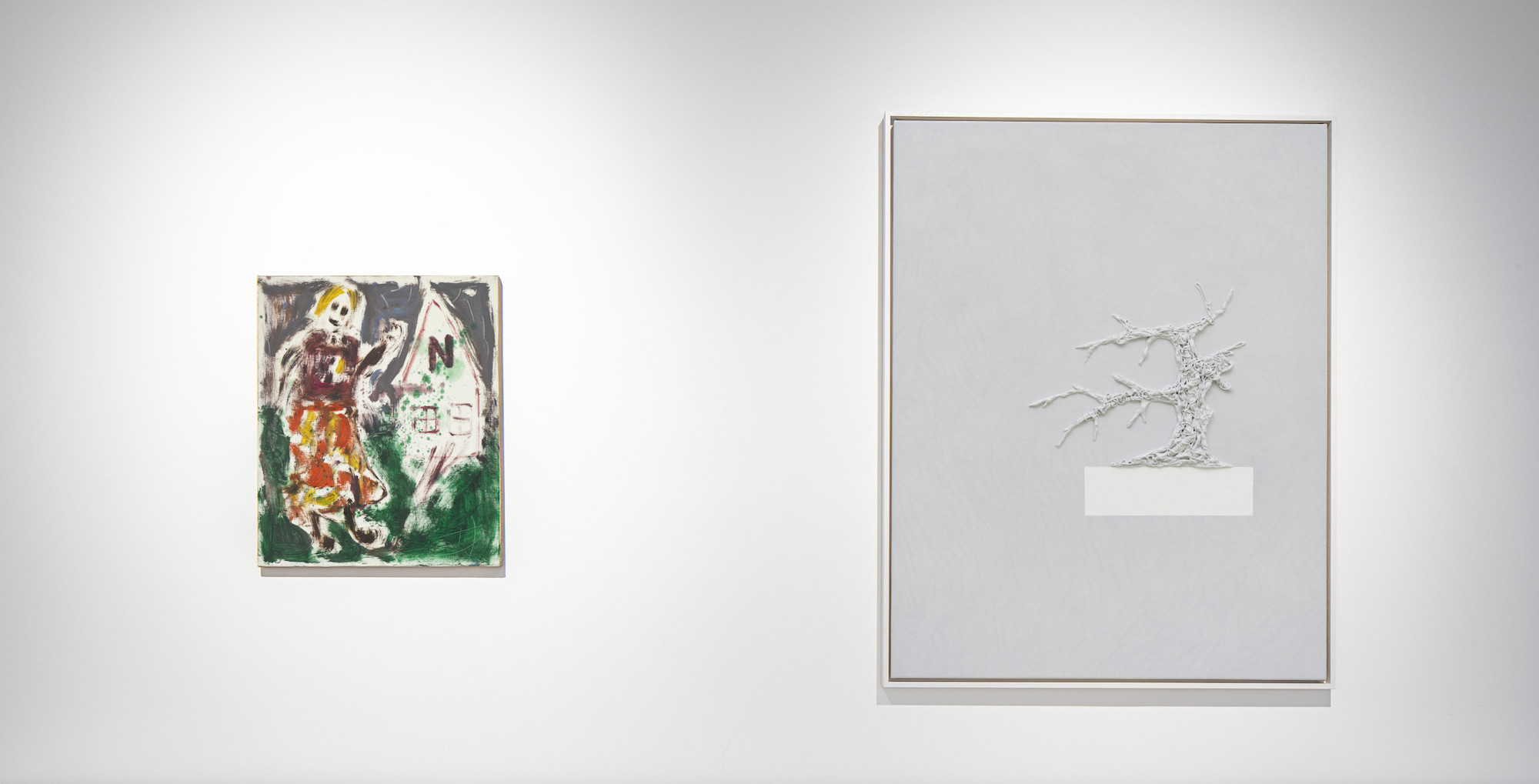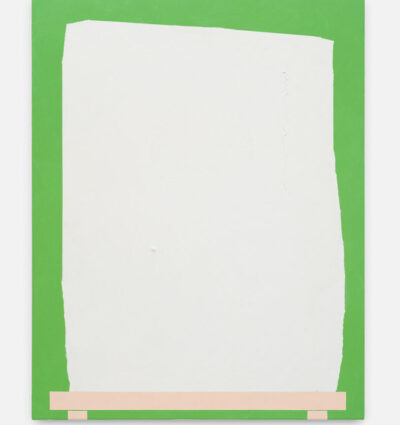THOMAS ARNOLDS | ANDRÉ BUTZER
Although different at first glance, the artistic practices of André Butzer and Thomas Arnolds reveal unexpected parallels. In their work, the developments and metamorphoses that painting has undergone in modern and postmodern times are reflected. For both painters, the seemingly irreconcilable categories of figuration and abstraction are no longer mutually exclusive. Rather, they are applied in free alternation to renegotiate the relationships between content, subject matter, form, color, surface, and composition, and to question painting’s significance for the present moment.




It is not only the painting of the 20th century that forms the foundation of André Butzer’s (*1973) work, but also all the horrors and promises it has brought forth. These include the National Socialist mass destruction as well as the premises of capitalist mass consumption, Friedrich Hölderlin as well as Walt Disney or Coca-Cola. Starting in 1999, based on this disruption of the 20th century, Butzer developed his Science-Fiction-Expressionism, which takes place in a universe inhabited by comic-like characters. These figures become his recurring pictorial personnel, in which the fundamental conflict of human existence, the inseparability of good and evil, is revealed. Past, present and future meet and create a fictional pictorial world, albeit one permeated by reality.
In 2001 Butzer created NASAHEIM, a cosmic place where the opposites and contradictions of earthly existence are suspended. The N-house, as well as the woman depicted in “Untitled” (2007) are elementary components of this painterly fiction. The woman is a mediator between the unreachable NASAHEIM and the world. This is also where the N-house is located and where all the colors are stored. The open, pictorial line lets her rise from the green of the ground and the blue of the sky as the guardian of colors. Starting in 2005, André Butzer begins to visibly dissolve his figures, their bodies and limbs. They develop into cable-like lines, which are applied directly from the tube to the canvas. Works like “Untitled” (2008) eliminate any content and pictorial function. Painting is confronted with itself, with the color, surface, and line.
With his N-pictures from 2010 to 2017, in which Butzer places black and white surfaces in relation to each other, he reaches the conceptual origin of his previous and future paintings. Only after several years the figures return, and with them an unbridled hunger for color. They are now neither figurative nor abstract. Like the female figure in “Untitled” (2013), they embody nothing but color, with which Butzer explores the nature of the painting itself.
In contrast, Thomas Arnolds (*1975) has devoted himself from the very beginning of his career to purely painterly questions. He purposely excludes any narrative aspect from his pictures. In series such as the Klinkerexpressionismus, Kitchen, Plan or RUNpictures, he develops a repertoire of formal, stylistic and color references that repeatedly meet and successively intermingle in different constellations.
To view Arnold’s series merely as self-contained or chronological sequences thus falls far short as his unwavering interest lies in fundamental questions about composition. From his earliest works, which translate Expressionist architecture into conceptual painting, to the Kitchen pictures, in which he transforms the modernist kitchen into monochrome, geometric forms in the three primary colors, to the most recent works of the RUN series, compositional questions are repeatedly addressed. Finally, it is revealed to the viewer how the picture is constructed and gains hold through the clash of colors, surfaces and forms.
In the RUN pictures, monochrome surfaces and the stump of a Greek column are the determining pictorial elements. The color fields only appear self-contained at first glance. On closer examination, they are constantly interrupted by the painter’s gesture. They also show relief-like structures or trees piled up on the surface of the canvas from thickly applied, overlapping masses of color. These color fields are now contrasted with an antique column composed of lines. But this archetype form of classical architecture is by no means rigid. It disintegrates into several parts, tapers, bends or has its lines sprout towards the center of the picture. In a general state of abstract dissolution, Thomas Arnolds still shows us how color becomes form and form becomes line.
Hannah Eckstein
Curator, Kunstverein Friedrichshafen, and Director of Collections at the Grässlin Foundation,
St. Georgen
Thomas Arnolds, born in Geilenkirchen, Germany in 1975, lives in Cologne, Germany.
Originally trained as a stonemason and sculptor, Arnolds studied with Walter Dahn at the Hochschule für Bildende Künste in Braunschweig.
Selected solo exhibitions have been shown at Kunstverein Reutlingen, Leopold-Hoesch-Museum in Düren, AK-Raum, Cologne, Galerie Bärbel Grässlin, Frankfurt am Main; Galerie Bärbel Grässlin, Frankfurt am Main, Galerie Hammelehle und Ahrens, Cologne, Jahn und Jahn, Munich, Künstlerverein Malkasten, Düsseldorf, Kunstverein Heppenheim and Nosbaum Reding, Luxembourg. The artist’s works have been presented in group exhibitions in international cities from Los Angeles to Beirut and Dubai.
Thomas Arnolds’ works are in possession of renowned collections such as the Kunstmuseum Bonn, the Leopold-Hoesch-Museum, Düren, and the Rotterdam Museum Boijmans van Beuningen.
André Butzer, born in Stuttgart in 1973, lives in Altadena, California.
Since 1996, his paintings have been the subject of numerous institutional exhibitions; solo exhibitions among others at IKOB Museum of Contemporary Art in Eupen, Belgium; Kestnergesellschaft in Hanover, Germany; Kunsthalle Nuremberg, Germany; Kunstverein Reutlingen, Germany; Museum of Light, Hokuto, Japan; Växjö Konsthall in Växjö, Sweden; and YUZ Museum, Shanghai, China.
Among others, works of his are part of the collections of the Art Institute of Chicago; Carré d’Art, Nîmes; Contemporary Art Collection of the Federal Republic of Germany, Bonn; Deichtorhallen Hamburg; Hall Art Foundation, Reading; Kupferstichkabinett, Berlin State Museums, Berlin, Germany; Nationalgalerie / Hamburger Bahnhof – Museum für Gegenwart, Berlin; LACMA, Los Angeles; MOCA, Los Angeles; Paula Modersohn-Becker Museum, Bremen; Rubell Museum, Miami; YUZ Museum, Shanghai.
Images:
Thomas Arnolds, RUN (y), 2018, oil on canvas, 200 x 270 cm
André Butzer, Untitled, 2013, oil on canvas, 250 x 200 cm
WORKS IN SHOW | ANDRÉ BUTZER
- André Butzer, Untitled, 2007 oil on canvas, 60 x 50 cm
- André Butzer, Untitled, 2008 oil on canvas, 60 x 40 cm
- André Butzer, Untitled, 2013 oil on canvas, 250 x 200 cm
WORKS IN SHOW | THOMAS ARNOLDS
- Thomas Arnolds, RUN (y), 2018 oil on canvas, 200 x 270 cm
- Thomas Arnolds, RUN (Chokkan), 2020 oil on canvas, 115 x 90 cm
- Thomas Arnolds, RUN (Grid/Web), 2020 oil on canvas, 115 x 90 cm
- Thomas Arnolds, RUN/BOLD-Series 2, 2020 wax crayon on paper, 33 x 33 cm
- Thomas Arnolds, RUN/BOLD-Series 4, 2020 wax crayon on paper, 33 x 33 cm
- Thomas Arnolds, RUN/BOLD-Series 3, 2020 wax crayon on paper, 33 x 33 cm
- Thomas Arnolds, RUN/BOLD-Series 1, 2020 wax crayon on paper, 33 x 33 cm
- Thomas Arnolds, RUN/BOLD-Series 5, 2020 wax crayon on paper, 33 x 33 cm
- Thomas Arnolds, RUN/BOLD-Series 6, 2020 wax crayon on paper, 33 x 33 cm














